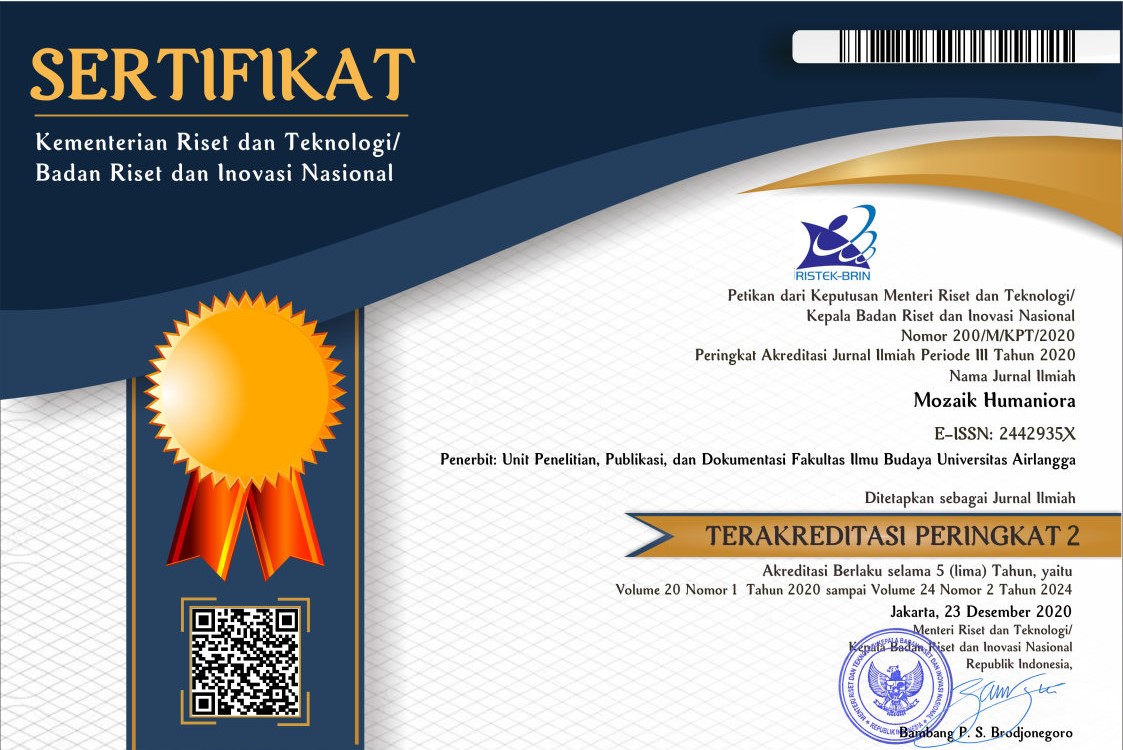Style' Bahasa dalam Teks Iklan Produk Bermakna Asosiatif Pornografi
Downloads
Muatan makna asosiatif pornografi merupakan salah satu cara iklan produk menarik perhatian khalayak konsumen. Untuk mengungkapkan isi, fungsi dan asosiasi-asosiasi produk memerlukan style bahasa yang mampu menginformasikan dan mempersuasi agar mendapat respon yang memadai. Metode kualitatif dengan teknik framing digunakan untuk memahami style bahasa iklan bermakna asosiatif pornografi. Hasil analisis menunjukkan fitur makna porno iklan produk mengacu seputar organ intim dan hubungan intim yang direpresentasikan dalam bentuk figuratif baik dalam elemen verbal dan nonverbal. Bentuk figuratif mewakili kelenturan tanda bahasa, selain tidak ‘vulgar', dapat mengurangi beban muatan makna porno. Muatan porno dikemas dengan style bahasa asosiatif dengan makna konotatif, stilistik, avektif, reflektif, dan kolokatif yang deskriptif untuk melengkapi produk daripada menawarkan produk, dan difungsikan untuk menunjukkan, menceritakan dan merangkum makna yang ingin disampaikan dalam iklan produk sebagai hal yang khusus.
Attwood, F. 2002. Reading porn: The paradigm shift in pornography research. Sexualities, 5(1), 91-105.
Bungin, Burhan. 2003. Pornomedia: Konstruksi Sosial Teknologi Telematika & Perayaan Seks di Media Massa. Jakarta: Pranada Media.
Ching, M. K., Haley, M. C., & Lunsford, R. F. 1980. The Theoretical Relation between Linguistic and Literary Studies: An Introduction by Editors. Linguistic Perspectives on Literature. London: Routledge & Kegan Paul, 1-38.
Cook, G. 2001. The discourse of advertising. Psychology Press.
Crook, J. 2004. On covert communication in advertising. Journal of Pragmatics, 36(4), 715-738.
Dale, Edgar (et al). 1971. Techniques of Teaching Vocabulary. Palo Alto, California : Field Education Publication, Incorporated.
Dyer, G. (2008). Advertising as communication. Routledge.
Entman, R. M. 1993. Framing: Toward clarification of a fractured paradigm. Journal of communication, 43(4), 51-58.
Fiske, John. 2012. Pengantar Ilmu Komunikasi.cet.ke-1. Jakarta: Rajawali Pers. .
Hagijanto, Andrian D. (2001).'Simbol budaya sebagai Representasi Positioning dalam Iklan Produk Mobil Eropa dan Mobil Jepang'. Nirmana, vol. 8 no, 2, hal,20-23. Jurnal Diskomvis Surabaya: UK Petra.
Huang, Y. (Ed.). 2017. The Oxford handbook of pragmatics. Oxford University Press.
Hall, Ann.C & Mardia J.Bishop. 2007. ‘Pornography-Sex in Mass Media' Pop-porn:Pornography in American Culture. no. I. Post Road West, Westport, London: Praeger Publishers
Jackson, Howard and Etienne Ze Amvela 2007. Words, Meaning and Vocabulary. London: Continuum International Publishing Group Ltd, Print.
Jefkins. 1997. Periklanan. Jakarta: Erlangga.
Keraf, Gorys. 2004. Diksi dan Gaya Bahasa. Jakarta: PT Gramedia Pustaka Utama.
Kreidler, C. W. 2013. Introducing English Semantics. Routledge.
Leech, Geoffrey. 1983. Principles of Pragmatics. New York: Longman
Lee, Monle & C. Johnson. 2007. Prinsip-prinsip Pokok Periklanan dalam Perpektif Global, Cet-2. Jakarta: Kencana Prenada Media Group.
Noviani, Ratna. 2002. Jalan Tengah Memahami Iklan.Yogyakarta: Pustaka Pelajar.
Forceville, C. Relevance Theory as Model for Analyzing Visual and Multimodal Communication:(version28/12/12).Availableat:<http://muldisc.files.wordpress.com/2013/08/chf20chapter20for20machin20ed202720dec20201220mouton20style20distributed20version.pdf>. Access on: 24 May 2014.
Munandar, Utami. 1999. Kreativitas dan Keberbakatan Strategi Mewujudkan Potensi Kreatif dan Bakat. Jakarta: Gramedia Pustaka Utama.
Saeed, J. I. 2003. Semantics. Malden: Blackwell Publisher Inc.
Sperber, D. & Wilson. D. 1995. Relevance: Communication and Cognition. Oxford: Blackwell.
Tanaka, K 1994. Advertising Language: a Pragmatic Approach to Advertisements in Britain and Japan. London:Routledge.
Vihma, Susan & Seppo Vá¾°keva. 2009. Semiotika Visual dan Semantika Produk, Pengantar Teori dan Praktik Penerapan Semiotika dalam Desain. Yogyakarta & Bandung: Jalasutra.
Widdowson, H. G. 1978. Teaching language as communication. Oxford University Press.
Wijana, I. 2003. Kartun: Studi Tentang Permainan Bahasa. Jogyakarta: Ombak.

Mozaik Humaniora is licensed under a Creative Commons Attribution-ShareAlike 4.0 International License. Both authors and Mozaik Humaniora agree with the following attribution of journal:
1. Copyright of this journal is possession of Author, by the knowledge of the Editorial Board and Journal Manager, while the moral right of the publication belongs to the author.
2. The journal allows the author(s) to retain publishing rights without restrictions
3. The legal formal aspect of journal publication accessibility refers to Creative Commons Attribution Share-Alike (CC BY-SA).
4. The Creative Commons Attribution Share-Alike (CC BY-SA) license allows re-distribution and re-use of a licensed work on the conditions that the creator is appropriately credited and that any derivative work is made available under "the same, similar or a compatible license”. Other than the conditions mentioned above, the editorial board is not responsible for copyright violation.


















